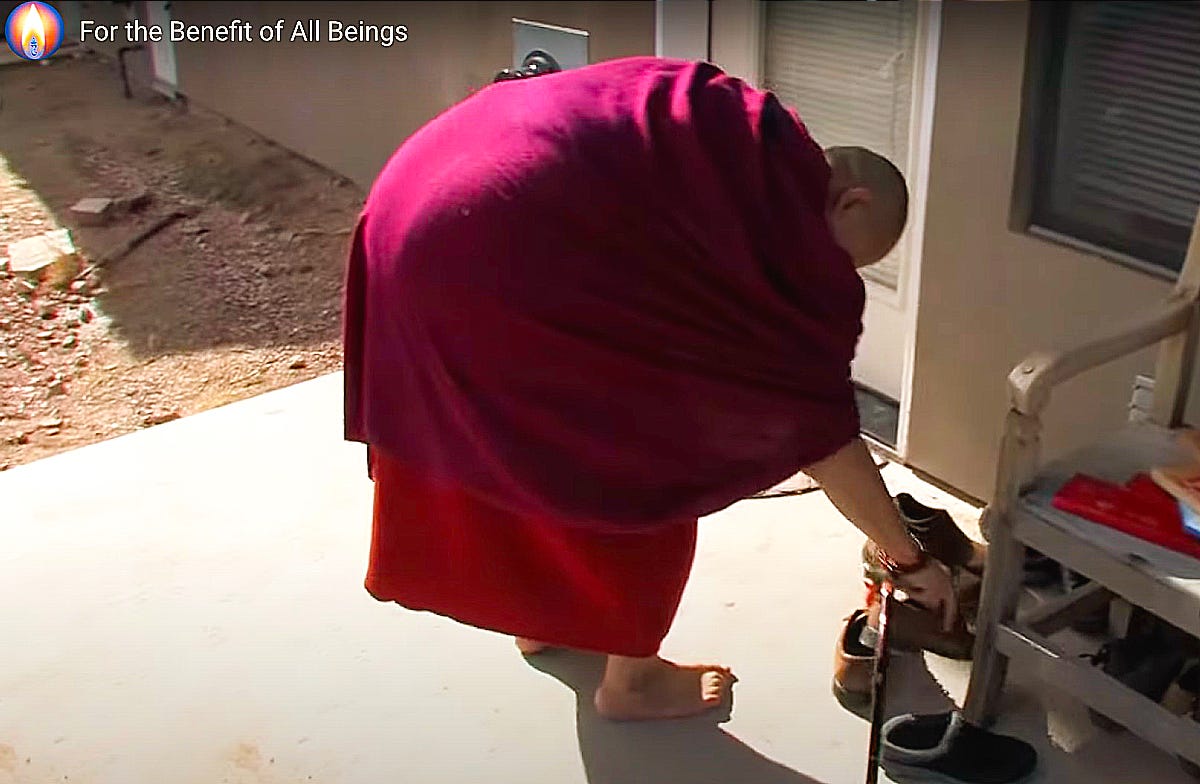A very young servant
Western cultures disparage servanthood.
Anyone perceived as a servant earns less money and less respect.
Teachers. Nurses. Farm workers. Food service workers. House cleaners. Childcare workers.
Hinduism teaches us that there are several possible, archetypal relationships between students and God or gurus. We may tend to embody any one of these, including the servant.
I’ve long-identified as servant. Even before I became aware of that orientation, I was naturally behaving as a servant.
This has taken many forms over the years, starting when I was a young child with my insistence on properly hosting guests.
Since then, I’ve learned more about servanting and about other spiritual practitioners who have also embodied this orientation such as Utpaladeva, Garchen Rinpoche, Patrul Rinpoche, and one of my own teachers, Wangdor Rinpoche.
I’ve also learned that in our hyper-individualized culture, servanting is received on a spectrum that includes joy, relief, relaxation, gratitude, incredulity, skepticism, paranoia, and outright rejection.

Archetypal relationships with God and guru in Hinduism
In the Hindu traditions, various styles of relating to God and guru are called bhavas. This means feeling orientations. They aren't something you decide on. You naturally gravitate toward a particular style given your unique dimension as a person.
Friend (sakhya bhava)
One archetypal relationship is that of friendship. The student relates to a teacher as a close companion. This relationship is marked by respect and open communication, allowing the student to express doubts and receive guidance.
Depending on the circumstance, sakhya bhava might be the orientation of a student who wants to benefit from a teacher’s wisdom, but who does not particularly relate to the teacher as guru.
Sakhya bhava might also appear as the profound intimacy, ease, and confidence experienced only by disciples who have recognized their root teacher.
Servant (dasya bhava)
The servant orientation involves modesty, dedication, obedience, service, and a certain degree of invisibility. The disciple or devotee serves guru and God tirelessly, recognizing that a more total dedication to following is the road to spiritual growth and liberation.
Beloved (madhurya bhava)
The beloved is an emotionally passionate and deeply loving orientation, most often embodied in the Bhakta traditions centered on Radha and Krishna. This orientation expresses intense longing for union with the divine and is traditionally, although not exclusively, directed toward a deity.
Child (bala bhava)
The guru is often regarded as a parental figure—both nurturing and disciplining the disciple. This orientation embodies the childlike, innocent, and trusting aspect of devotion. It reflects a deep sense of surrender and reliance on the guru’s guidance, akin to a child's trust in a parent for protection and sustenance.
Anandamayi Ma pointed to another way of embodying bala bhava. She often referred to herself as “your little girl” or “your little daughter.” In this way, she encouraged disciples to care for her as a parent would care for a child. Eventually, disciples could learn to care for everyone in this manner.
Equality with guru (abheda bhava)
Some more realized disciples perceive the guru’s essence and realize that it is nondifferent from their own. The fundamental distinction between guru and disciple dissolves, and each can be experienced as one self playing both roles. This recognition is an aspect of discovering the equality of all phenomena.
Abheda bhava can emanate from the heart of any of the other bhavas.
Infinite mode
Because these styles of relating are native forms of self-expression and not manufactured, they spill over into our relationships with everyone and even everything. The recognition of my servant aspect has become more rich and useful as I contemplate how it has shown up in so many areas of my life over the years.
Even if one has some realization, the playful forms of relating that the bhavas represent need not be abandoned.
Utpaladeva, the early 10th century Kashmiri siddha, imagined remaining in the role of servant to Lord Shiva forever.
Show me the inner path!
Make disappear completely
The ways of the entire world
So that in an instant, O Lord,
I may become your servant forever.1
Some game apps switch into infinite mode after the levels of the game are completed. Infinite mode has no scoring and nothing to achieve. It just continues for the sake of pure enjoyment.
And so can we.
with infinite love,
Shambhavi
Not quite ready to fire up a paid subscription, but want to show your appreciation?
Please join Shambhavi and the Jaya Kula community for satsang & kirtan every Sunday at 3:00pm Pacific. Come in person to 1215 SE 8th Ave, Portland, OR, or join Jaya Kula’s newsletter to get the Zoom link for satsang. You can also listen to my podcast—Satsang with Shambhavi—wherever podcasts are found.
Utpaladeva, Shaiva Devotional Songs of Kashmir, transl. Constantina Rhodes Bailly (SUNY Press 1987): 43.






This feels like following bread crumbs to the summer retreat 🌈✨ It’s such a unique relationship, there’s nothing else like it.